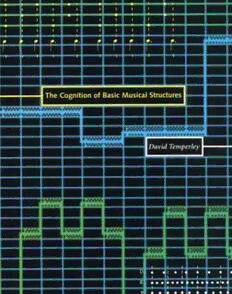Table Of ContentThe Cognition of Basic Musical Structures
This page intentionally left blank
The Cognition of Basic Musical Structures
David Temperley
The MIT Press
Cambridge, Massachusetts
London,England
(2001MassachusettsInstituteofTechnology
Allrightsreserved.Nopartofthisbookmaybereproducedinanyformbyany
electronic ormechanical means (including photocopying, recording, or informa-
tionstorageandretrieval)withoutpermissioninwritingfromthepublisher.
This book was set in Sabon on 3B2 by Asco Typesetters, Hong Kong and was
printedandboundintheUnitedStatesofAmerica.
LibraryofCongressCataloging-in-PublicationData
Temperley,David.
Thecognitionofbasicmusicalstructures/DavidTemperley.
p. cm.
Includesbibliographicalreferencesandindex.
ISBN0-262-20134-8(hard:alk.paper)
1.Musictheory—Dataprocessing. 2.Musicalperception—Computer
simulation. I.Title.
MT6.T35C62001
781—dc21 00-054801
Contents
Preface ix
Acknowledgments xiii
Introduction 1
1.1 An Unanswered Question 1
1.2 Goals and Methodology 4
1.3 Music Cognitionand Music Theory 8
1.4 The Input Representation 9
1.5 The Preference Rule Approach 13
1.6 The Implementation Strategy 14
I 2 Metrical Structure 23
SixPreference Rule 2.1 Meter 23
Systems 21 2.2 PreviousResearchon Metrical Analysis 27
2.3 A PreferenceRule System for Meter 30
2.4 Implementation 39
2.5 Tests 42
2.6 Problems and Possible Improvements 44
2.7 Other Factors inMetricalStructure 48
2.8 Choosing the Right Tactus 52
3 Melodic Phrase Structure 55
3.1 Musical Groupingand Phrase Structure 55
3.2 Studies of MusicalGrouping inPsychology 56
3.3 Models of Grouping Structure 60
3.4 A Preference Rule System for MelodicPhraseStructure 65
3.5 Implementation and Tests 71
3.6 Groupingin PolyphonicMusic 76
4 Contrapuntal Structure 85
4.1 Counterpoint 85
4.2 Sequential Integration inAuditory Psychology 87
4.3 Computational Models ofContrapuntal Analysis 91
4.4 A Preference Rule System for Contrapuntal Analysis 96
4.5 Implementation 102
4.6 Tests 106
5 Pitch Spelling and the Tonal-Pitch-ClassRepresentation 115
5.1 Pitch-Class, Harmony,and Key 115
5.2 Spatial Representations in Music Theory 116
5.3 Tonal-Pitch-Class Labeling 123
5.4 A Preference Rule System for Tonal-Pitch-Class
Labeling 124
5.5 Implementation 132
5.6 Tests 134
6 HarmonicStructure 137
6.1 Harmony 137
6.2 ExperimentalandComputational Work on Harmonic
Analysis 139
6.3 A Preference Rule System for HarmonicAnalysis 147
6.4 Implementation 154
6.5 SomeSubtle Features of theModel 159
6.6 Tests 162
6.7 Other Aspectsof HarmonicStructure 164
7 Key Structure 167
7.1 Key 167
7.2 Psychologicaland Computational Work on Key 168
7.3 The Krumhansl-Schmuckler Key-Finding Algorithm 173
7.4 Improvingthe Algorithm’s Performance 176
7.5 Modulation 187
7.6 Implementation 188
7.7 Tests 191
7.8 An Alternative Approach toModulation 198
II 8 Revision, Ambiguity,andExpectation 205
Extensions and 8.1 Diachronic Processing and Ambiguity 205
Implications 203 8.2 Modeling the Diachronic Processingof Music 206
vi Contents
8.3 Examples of Revision 210
8.4 Revisionin Tonal Analysis 215
8.5 Synchronic Ambiguity 219
8.6 Ambiguity in Contrapuntal Structure 224
8.7 Ambiguity in Meter 228
8.8 Expectation 231
9 Meter,Harmony,and Tonality inRock 237
9.1 Beyond Common-Practice Music 237
9.2 Syncopation inRock 239
9.3 Applicationsand Extensions ofthe Syncopation Model 247
9.4 Harmony in Rock 253
9.5 Modality and Tonicization in Rock 258
10 Meter and Groupingin African Music 265
10.1 AfricanRhythm 265
10.2 Meter inAfricanMusic 268
10.3 How IsMeter Inferred? 272
10.4 Western and African Meter:A Comparison 276
10.5 Hemiolas and the ‘‘Standard Pattern’’ 279
10.6 ‘‘Syncopation Shift’’ inAfricanMusic 282
10.7 Grouping Structure inAfricanMusic 286
10.8 Conclusions 289
11 Style,Composition, and Performance 291
11.1 The Study of Generative Processesin Music 291
11.2 DescribingMusical Styles and CompositionalPractice 292
11.3 FurtherImplications:IsSome Music ‘‘Nonmetrical’’? 299
11.4 Preference Rulesas Compositional Constraints:Some
RelevantResearch 305
11.5 Preference RuleScoresand MusicalTension 307
11.6 Performance 317
12 Functions of the Infrastructure 325
12.1 Beyond the Infrastructure 325
12.2 Motivic Structure and Encoding 326
12.3 Musical Schemata 336
12.4 Tension and Energy 339
12.5 The Functions of Harmonyand Tonality 340
12.6 Arbitrariness 345
12.7 Explaining Musical Details: AnExercise in
Recomposition 349
12.8 The Power ofCommon-Practice Music 354
vii Contents
Appendix:List of Rules 357
Notes 361
References 381
Author Index 393
Subject Index 397
viii Contents
Preface
Thisbookaddressesafundamentalquestionaboutmusiccognition:how
do we extract basic kinds of musical information—meter, phrase struc-
ture, counterpoint, pitch spelling, harmony, and key—from music as we
hear it? My approach to this question is computational: I develop com-
puter models for generating these aspects of structure, with the aim of
simply solving the computational problems involved as elegantly and
effectively as possible, and with the assumption that this approach may
shed light on how the problems are solved in cognition. The models I
propose are based on preference rules. Preference rules are criteria for
evaluatingapossibleanalysisofapiece(intermsofsomekindofmusical
structure). In a preference rule system, many possible interpretations are
considered,and the one is chosen that bestsatisfiesthe rules.
I begin with an introductory chapter, describing the overall goals and
methodology of the project and overviewing the theoretical and imple-
mentationalstrategy.Theremainderofthebookisthendividedintotwo
parts. In part I, I present preference rule systems for generating six basic
kinds of musical structure. Metrical structure is a framework of levels
of beats. Melodic phrase structure is a segmentation of the input into
phrases; the model I propose is applicable only to melodies, not poly-
phonictextures.Contrapuntalstructureisasegmentationofapolyphonic
textureintomelodiclines.Pitchspelling,whichIalsocallthetonal-pitch-
class representation, involves a labeling of pitch events in a piece with
spellings (‘‘tonal-pitch-class’’ labels) such as A" or G#. Harmonic struc-
ture is a segmentation of a piece into harmonic segments labeled with
roots. The preference rule systems for pitch spelling and harmonic struc-

